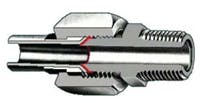When a call comes in for help at a nuclear power plant, you must move quickly to resolve any problems. That’s why Jim Shackelford, a sales consultant for Control and Power, Birmingham, Ala., recently found himself at a nuclear power generating plant on a Sunday afternoon.
Evaluating the risks
Shackleford soon discovered the small leaks could cause serious problems. Aggressive phosphate-ester hydraulic fluid can be dangerous, is harmful to humans, and was leaking in a critical containment area. Attempting to stop the leaks, the maintenance personnel had re-tightened each fitting, without success. Adding to the problem, their scheduled maintenance downtime was due to expire soon. Additional days of downtime would cost the company millions in lost revenue.
“To correctly identify the problem, I ‘suited up’ in protective clothing and entered the containment area to inspect the leaking fittings. The fittings had been installed when the plant was built more than 35 years ago,” Shackleford said.
Close inspection revealed that the fittings were not tube compression but 37° flared fittings mated with 316 stainless-steel tubing. Sizes ranged from 38- to 2-in. tube diameters. Usually, this would require cutting out the old fittings and re-tubing the system, but this was rejected due to time constraints and high costs.
Strict approvals needed
Armed with the knowledge that the fittings were flare fittings, Shackleford worked with Vita Accetta at Flaretite Inc., Fenton, Mich., to determine what type of fitting would work best. The recommendation was to install Flaretite Seals, but the engineering department had to ensure the seal would not compromise the system in any way. The original equipment manufacturer was contacted, and approval from its environmental department was required. Only then could Flaretite Seals be approved for installation.
Flaretite 316 stainless-steel seals were chosen to match the existing metallurgy. Normally, these seals incorporate a Loctite polymer coating as an extra safeguard against leakage. However, uncoated seals were chosen to avoid the potential of radiation degradation of the sealant polymer. Flaretite's sealing rings were deemed adequate to seal the leaks, even without requiring Loctite coating.
Installation a success
To ensure that each seal was properly installed, open-ended Torqtite wrenches were used to tighten the different sized fittings to the manufacturer’s torque recommendation.
Finally, the system was refilled with hydraulic fluid and pressurized.
Unfortunately, several fittings were still leaking. Re-inspection revealed that these particular fittings were missed during the tightening sequence. Simply applying the Torqtite wrench to the leaking fitting and tightening to the required torque stopped each leak. The maintenance personnel were impressed with this simple fix and the ease of adding a Flaretite seal to their existing fittings. No fittings had to be replaced, and no tubing needed to be cut, reflared, or replaced.
The power plant has subsequently ordered Flaretite Seals for its other turbine systems scheduled for future maintenance.
For information, contact Jim Shackelford at (877) 835-5274 or Vito Accetta at Flaretite Inc. at (810) 750-4140, www.flaretite.com, or email [email protected].



